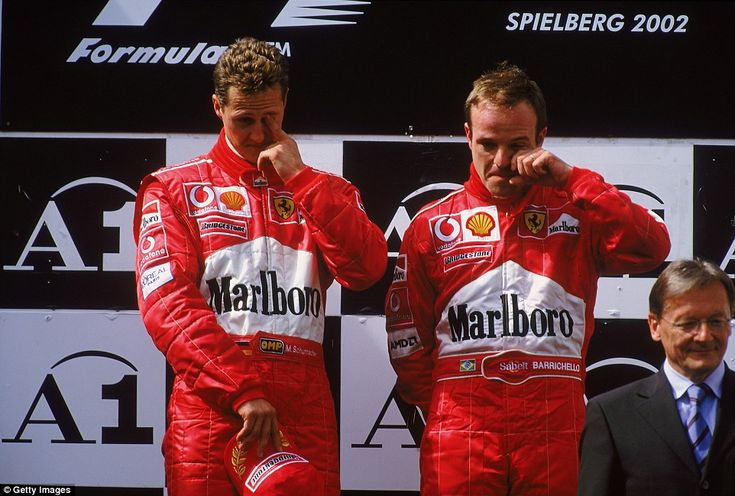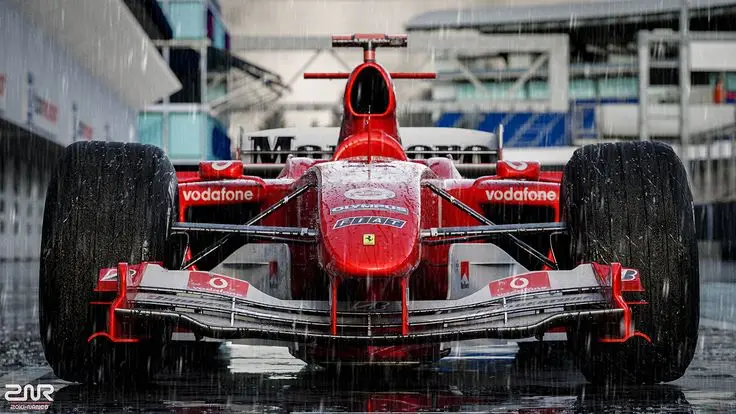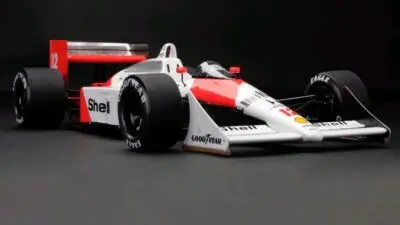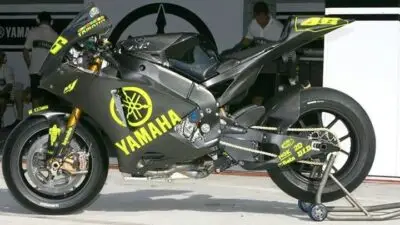The 2004 Formula 1 season stands as one of the most dominant campaigns in motorsport history. Michael Schumacher and Ferrari created a nearly perfect partnership that year, with the German driver securing his seventh and final world championship. The key to this success was the Ferrari F2004, a racing machine that redefined what it meant to dominate in Formula 1.

The Ferrari F2004 won 15 of 18 races in 2004, giving Schumacher his record-breaking seventh world championship and establishing itself as one of the most successful cars in F1 history. The car’s engineering excellence and reliability made it nearly unbeatable on track. Schumacher’s teammate Rubens Barrichello also found success with the F2004, helping Ferrari secure the constructors’ championship.
This incredible machine represents the peak of Ferrari’s early 2000s dominance and Schumacher’s legendary career. The F2004’s design, performance, and the team behind it created a combination that competitors struggled to match. Understanding how this car achieved such remarkable success reveals important lessons about engineering, teamwork, and the pursuit of racing perfection.
Key Takeaways
- The Ferrari F2004 delivered unprecedented dominance with 15 race wins and both championship titles in 2004
- Advanced engineering and reliable performance made the F2004 nearly unbeatable against all competitors
- The car represents the pinnacle of Schumacher’s career and Ferrari’s golden era in Formula 1
Design and Engineering of the Ferrari F2004

The Ferrari F2004 featured advanced aerodynamic design and a powerful V10 engine that dominated the 2004 Formula 1 season. The chassis was designed by Rory Byrne, Ignazio Lunetta, Aldo Costa, Marco Fainello, John Iley and James Allison with extensive testing at Imola refining its performance.
Chassis and Aerodynamics Innovations
The F2004 chassis represented a major step forward in Formula 1 design. Rory Byrne led the chassis design while working with a team of skilled engineers.
The car’s aerodynamic package was revolutionary for its time. The front wing featured complex endplates that directed airflow around the front wheels. The rear wing design maximized downforce while reducing drag.
Key aerodynamic features included:
- Advanced front wing endplates
- Optimized sidepod design
- Sophisticated rear diffuser
- Improved airflow management
The chassis used carbon fiber construction that made it both light and strong. This weight reduction improved handling and acceleration throughout the race.
Engine Performance and Technical Specifications
The F2004 used a naturally aspirated V10 engine that delivered exceptional power. The engine was not only powerful but also reliable, allowing drivers to push hard without mechanical failures.
Engine specifications:
- Type: V10 naturally aspirated
- Displacement: 3.0 liters
- Power output: Approximately 900 horsepower
- Rev limit: 19,000 RPM
The engine featured advanced materials and precision engineering. Titanium valves and lightweight pistons helped it reach high RPMs safely.
The gearbox was a seven-speed semi-automatic unit. Quick shift times gave the F2004 an advantage during overtaking and defending positions.
Development Process and Testing at Imola
Ferrari conducted extensive testing at Imola to develop the F2004. The Italian circuit’s high-speed corners and technical sections made it perfect for car development.
Test drivers worked with engineers like Andrea Stella to fine-tune the car’s setup. They tested different aerodynamic packages and suspension settings during these sessions.
The team ran thousands of kilometers at Imola before the season started. This testing revealed areas where the car could be improved and validated design choices.
Testing focused on:
- Aerodynamic balance
- Tire performance
- Fuel consumption
- Reliability under race conditions
Engineers like Rob Smedley analyzed data from each test session. This information helped them understand how to extract maximum performance from the F2004 during race weekends.
The 2004 Formula 1 Season: Timeline of Triumph

The 2004 Formula One season ran from March 7 to October 24 across 18 races, with Michael Schumacher winning 13 races and securing his seventh championship. Ferrari’s dominance reached unprecedented levels as they won 15 of the 18 races throughout the season.
Schumacher’s Winning Streak
Michael Schumacher began the 2004 season with extraordinary momentum. He won the opening race in Australia and continued his dominance through the early rounds.
The German driver secured 12 victories in the first 13 races. His only failure to win during this stretch came at Monaco, where he crashed out of the race.
This winning streak established a new standard for F1 dominance. Schumacher’s consistency behind the wheel of the Ferrari F2004 was unmatched by any competitor.
The streak included victories at Imola, where Ferrari traditionally performed well. His teammate Rubens Barrichello provided strong support throughout the campaign.
By mid-season, Schumacher had already built an insurmountable points lead. The championship was effectively decided before the summer break.
Races and Record-Breaking Performances
Schumacher won 13 out of 18 races during the 2004 Formula 1 season. This performance set new benchmarks for single-season dominance in the sport.
Ferrari as a team won 15 of the 18 races. When Schumacher didn’t win, Barrichello often stepped up to take victory for the Italian team.
The few races Ferrari didn’t win went to other manufacturers like Renault and McLaren. Juan Pablo Montoya managed to secure victories when the Ferrari drivers faltered.
Several races required safety car interventions, but Ferrari’s strategy team consistently made the right calls. Their pit stop execution remained flawless throughout the season.
The Ferrari F2004 proved nearly unbeatable on every type of circuit. From high-speed tracks to technical street circuits, the car performed at the highest level.
Strategic Battles Against Rivals
Despite Ferrari’s dominance, other teams fought hard to challenge their supremacy. Renault emerged as the strongest competitor, developing competitive strategies to counter Ferrari’s advantage.
McLaren struggled to match Ferrari’s pace consistently. Their drivers found it difficult to mount sustained challenges against Schumacher and Barrichello.
Juan Pablo Montoya provided some of the season’s most intense battles. His aggressive driving style created memorable wheel-to-wheel combat with the Ferrari drivers.
Key rival teams:
- Renault – strongest consistent challenger
- McLaren – intermittent threat on specific circuits
- Williams – competitive but inconsistent
Ferrari’s strategic superiority extended beyond pure speed. Their tire management and fuel strategies consistently outmaneuvered the competition.
The team’s ability to adapt race strategies in real-time gave them crucial advantages. When safety cars or weather changes occurred, Ferrari responded faster than their rivals.
Michael Schumacher and Rubens Barrichello: Driver Synergy

The 2004 Formula 1 season showcased Michael Schumacher’s dominance in the Ferrari F2004, while Rubens Barrichello claimed nine wins for Ferrari from 2000-2005, partnering Michael Schumacher at the team. Ferrari’s championship success relied heavily on team orders and clear driver hierarchy that prioritized Schumacher’s title ambitions.
Schumacher’s Seventh Title Run
Michael Schumacher delivered one of his most commanding seasons in 2004, securing his seventh world championship. The German driver won 13 out of 18 races that year, clinching the title with four races remaining.
His partnership with the Ferrari F2004 proved unstoppable on track. Schumacher finished on the podium in 15 races and secured 8 pole positions throughout the season.
Ferrari and Michael Schumacher were one of the most successful partnerships in the history of the sport, winning five consecutive championships between 2000 and 2004. The 2004 campaign marked the peak of this collaboration.
The championship was mathematically secured at the Belgian Grand Prix in August. This early title victory demonstrated both Schumacher’s skill and the Ferrari F2004’s technical superiority over the competition.
Barrichello’s Role in the Team
Rubens Barrichello served as the perfect supporting driver for Ferrari’s championship ambitions. Ferrari only ever saw him as a strong support to Schumacher’s championship ambitions.
The Brazilian driver won two races in 2004 at the Chinese and Italian Grands Prix. He finished third in the drivers’ championship with 114 points, behind Schumacher’s dominant 148 points.
Rubens Barrichello revealed his first instance of being told to hold station behind Michael Schumacher came in his first race at Ferrari. Team orders became a regular part of Ferrari’s strategy throughout their partnership.
Barrichello consistently delivered strong performances when called upon. His reliability and speed made him an ideal teammate for maximizing Ferrari’s constructor points while supporting Schumacher’s title bids.
Team Dynamics and Collaboration
The Ferrari team structure clearly favored Schumacher as the lead driver. Michael Schumacher was an extremely tough competitor on track and demanded complete team focus on his championship campaigns.
Key aspects of their partnership:
- Clear driver hierarchy with Schumacher as number one
- Strategic team orders to maximize championship points
- Shared technical feedback to develop the Ferrari F2004
- Professional respect despite competitive tensions
The collaboration extended beyond race weekends. Both drivers worked closely with Ferrari’s technical team to refine the F2004’s setup and performance characteristics.
Michael Schumacher never offered any help as a teammate, according to Barrichello’s later reflections. This competitive approach contributed to Schumacher’s dominance but created tension within the team dynamic.
Their professional relationship delivered results for Ferrari. The team secured both the drivers’ and constructors’ championships in 2004, with the F2004 proving to be one of the most successful Formula 1 cars ever built.
Key Technical Team and Behind-the-Scenes Leadership

The Ferrari F2004’s success came from a team of skilled engineers and technical experts who worked behind the scenes. Andrea Stella provided crucial race strategy insights, Luca Baldisserri contributed key engineering solutions, and Rob Smedley brought valuable testing knowledge to the project.
Andrea Stella’s Insights
Andrea Stella served as one of Ferrari’s key performance engineers during the F2004 era. He worked closely with Michael Schumacher to analyze race data and improve car setup.
Stella focused on telemetry analysis and race strategy development. He studied tire performance data and fuel consumption patterns to help create winning race plans.
His work helped Ferrari understand how the F2004 performed in different weather conditions. Stella’s data analysis showed which setup changes worked best at each track.
The Italian engineer also contributed to communication systems between the pit wall and drivers. He helped develop clearer radio protocols that allowed faster decision-making during races.
Stella’s technical background in aerodynamics proved valuable when Ferrari needed to adjust the F2004’s wing settings. His insights helped the team find the right balance between speed and downforce.
Luca Baldisserri’s Engineering Contributions
Luca Baldisserri played a crucial role as Ferrari’s chief engineer during the F2004 development period. He oversaw technical aspects of car setup and race weekend operations.
Baldisserri managed the engineering team that worked directly with Schumacher and teammate Rubens Barrichello. He coordinated between different departments to solve technical problems quickly.
His expertise in suspension systems helped Ferrari fine-tune the F2004’s handling characteristics. Baldisserri worked on spring rates and damper settings that gave drivers better control.
The engineer also supervised brake system development for the F2004. He ensured the car could handle the extreme heat and stress of Formula 1 racing without mechanical failures.
Baldisserri’s leadership style focused on clear communication and quick problem-solving. He helped create an efficient workflow that allowed Ferrari to make rapid improvements between practice sessions.
Rob Smedley’s Testing Expertise
Rob Smedley brought valuable testing experience to Ferrari during the F2004 program. He worked as a test engineer and helped develop the car’s performance capabilities.
Smedley’s background in data acquisition systems proved essential for understanding the F2004’s behavior. He collected and analyzed information from hundreds of sensors on the car.
His testing work focused on tire development and setup optimization. Smedley conducted extensive tests at Ferrari’s Fiorano test track to find the best tire compounds and pressures.
The British engineer also contributed to aerodynamic testing programs. He helped Ferrari understand how different wing configurations affected the F2004’s speed and stability.
Smedley’s methodical approach to testing helped Ferrari identify small improvements that added up to significant performance gains. His work provided the foundation for the car’s dominant 2004 season.
Rivalry and Competition in the 2004 Formula 1 Season

Despite Ferrari’s overwhelming dominance, McLaren and Renault provided the strongest opposition throughout the season. Juan Pablo Montoya emerged as Schumacher’s most consistent rival, while safety car periods occasionally disrupted Ferrari’s strategic advantage.
Major Challengers: McLaren, Renault, and Others
McLaren posed the biggest threat to Ferrari’s dominance in 2004. Juan Pablo Montoya drove aggressively and secured three race victories during the season. His wins came at Monaco, where Schumacher crashed, and at Silverstone and Monza.
Kimi Räikkönen partnered Montoya at McLaren. The Finnish driver showed strong pace but struggled with reliability issues. The McLaren MP4-19 proved competitive on certain tracks but lacked the consistency of the Ferrari F2004.
Renault emerged as Ferrari’s home threat at the French Grand Prix. The team had strong performance at Magny-Cours but Ferrari stole victory with a secret four-stop strategy. Jenson Button won the only other non-Ferrari victory at the Hungarian Grand Prix for BAR-Honda.
Incidents and Controversies
The Monaco Grand Prix provided the season’s biggest upset. Schumacher crashed during practice and started from the back of the grid. This rare mistake allowed Montoya to claim victory and break Ferrari’s winning streak.
Several technical disputes arose throughout the season. Teams questioned Ferrari’s tire advantage and aerodynamic innovations. The FIA conducted multiple inspections but found no rule violations.
Driver rivalries intensified as competitors grew frustrated with Ferrari’s dominance. Montoya publicly criticized the lack of competition. Other drivers called for rule changes to level the playing field for future seasons.
The Impact of the Safety Car
Safety car periods occasionally disrupted Ferrari’s race strategies. The team’s superior pit stop execution usually maintained their advantage during these interruptions. Ferrari’s reliability meant they rarely benefited from safety cars caused by mechanical failures.
Strategic gambles during safety car periods sometimes backfired for competitors. Teams attempting alternative strategies to beat Ferrari often found themselves out of position. The safety car’s influence remained minimal compared to Ferrari’s raw pace advantage throughout the 2004 season.
Legacy and Influence of the Ferrari F2004

The Ferrari F2004 left an enduring mark on Formula 1 through record-breaking performances and technological innovations. Its success created lasting value for collectors while shaping modern racing car development.
Records Set and Lasting Achievements
The Ferrari F2004 won 15 of 18 races during the 2004 season. Michael Schumacher secured his seventh and final world championship with this car. The machine delivered 13 wins for Schumacher out of his first 13 races.
Ferrari’s dominance extended beyond race wins. The team claimed their sixth straight Constructors’ Championship. The F2004 achieved 12 pole positions and 14 fastest laps throughout the season.
The car set numerous track records across different circuits. Testing revealed the F2004 was up to two seconds faster per lap than its predecessor. This performance gap was unprecedented in Formula 1.
Collector Value and Ferrari Client Program
The Ferrari F2004’s racing success translated into significant collector value. An F2004 chassis sold for $3.2 million at auction. This price reflects the car’s historical importance and racing pedigree.
Ferrari developed client programs allowing private collectors to own F2004 chassis. These programs gave enthusiasts access to authentic Formula 1 machinery. The F2004 became one of the most sought-after modern Formula 1 cars for private collectors.
The car’s value continues to appreciate due to its connection to Schumacher’s final championship. Collectors prize the F2004 as the car with which Michael Schumacher won his record-breaking seventh title.
Influence on Modern Formula 1
The F2004’s aerodynamic innovations influenced future Formula 1 car designs. Ferrari’s suspension improvements and tire optimization techniques became industry standards. Modern teams still study the F2004’s engineering solutions.
Current Ferrari personnel reference the F2004’s success for motivation. Andrea Stella uses 2004 Ferrari success to inspire modern racing teams. The car represents peak performance achievement in Formula 1.
The F2004’s dominance also influenced regulation changes. Formula 1 officials implemented new rules to prevent similar levels of dominance. These changes aimed to maintain competitive balance in the sport.
Modern drivers like Sebastian Vettel have cited the F2004 as an inspiration. The car’s reputation for speed and reliability set benchmarks for contemporary Formula 1 machines.
Frequently Asked Questions

The Ferrari F2004 dominated Formula 1 through superior engineering and Michael Schumacher’s driving skill. This championship-winning car set multiple records and outperformed competitors with its advanced V10 engine and aerodynamic design.
How did the Ferrari F2004 contribute to Michael Schumacher’s success?
The Ferrari F2004 gave Schumacher the perfect tool to secure his seventh and final world championship. The car’s superior speed and reliability allowed him to win a record-breaking 13 races in a single season.
Ferrari and Schumacher won 15 out of 18 races during the 2004 season. This level of dominance was rarely seen in Formula 1 history.
The F2004’s technical excellence matched Schumacher’s driving abilities perfectly. Together, they created one of the most successful driver-car combinations in motorsport.
What are the defining technical specifications of the Ferrari F2004?
The F2004 featured advanced aerodynamics that improved downforce and reduced drag. Its lightweight carbon fiber construction provided the perfect balance of strength and speed.
The car used sophisticated suspension systems that enhanced handling on different track surfaces. Electronic systems helped optimize performance during races.
Ferrari designed the F2004 with precise weight distribution. This gave Schumacher better control through corners and improved overall stability.
What engine was used in the Ferrari F2004 and what was its performance output?
The F2004 used a naturally aspirated 3.0-liter V10 engine. This powerplant delivered exceptional performance throughout the 2004 season.
The V10 engine produced over 900 horsepower at high RPM. It provided strong acceleration and top speeds that dominated competitors.
Ferrari’s engine department created one of the most reliable V10 units of the era. The engine rarely failed during races, contributing to the team’s championship success.
What records were set by the Ferrari F2004 during its competitive years?
The F2004 appeared in 20 races and scored 15 wins, with 13 victories going to Schumacher. The car also achieved 30 podium finishes and 12 pole positions.
Schumacher’s 13 race wins in 2004 set a single-season record. The F2004 also recorded 14 fastest laps and set numerous track records around the world.
The car helped Ferrari secure their sixth straight Constructors’ Championship. This achievement demonstrated the F2004’s consistent performance across different circuits.
How does the Ferrari F2004 compare to other Formula 1 cars of its era in terms of speed and agility?
The F2004 was faster than the Renault R24, its main competitor in 2004. However, Renault sometimes had better tire performance on specific weekends.
The Ferrari showed superior race pace compared to Williams, McLaren, and other teams. Its combination of speed and reliability gave it a clear advantage over the field.
The F2004’s aerodynamic efficiency allowed it to maintain high speeds through corners. This agility helped Schumacher overtake competitors and defend positions effectively.
In which races and championships did the Ferrari F2004 seal its legacy?
The F2004 secured Schumacher’s seventh drivers’ title and Ferrari’s 13th Constructors’ Championship in 2004. This marked the peak of their partnership.
Key victories included dominant wins at circuits like Imola, Barcelona, and Monza. The car performed well on both high-speed tracks and technical circuits.
The F2004’s success made it one of Ferrari’s championship-winning cars from the 2000-2004 era. These vehicles now sell for mid-seven figures due to their racing heritage.



